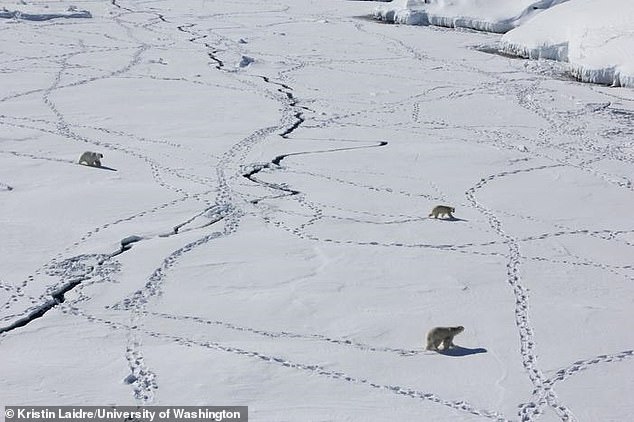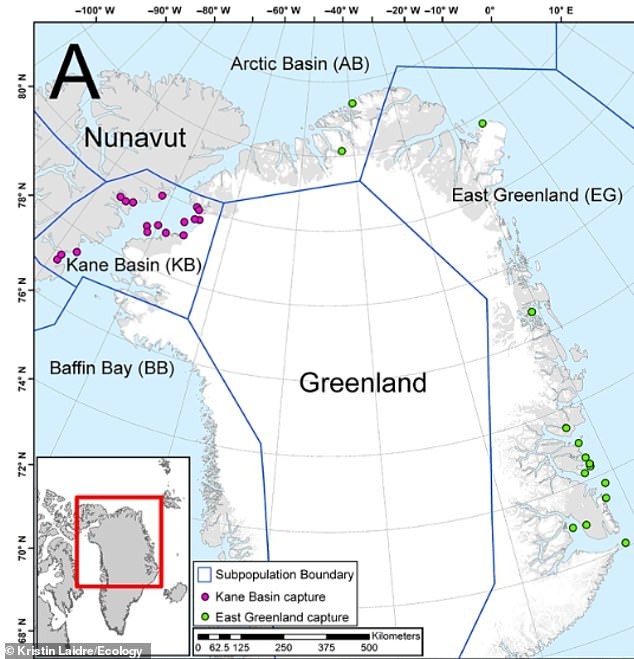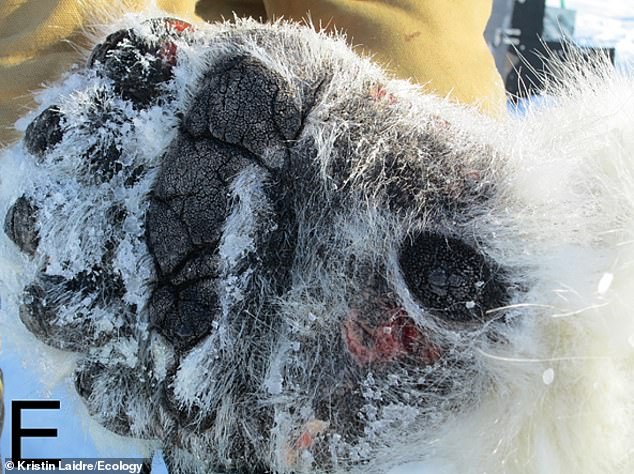Polar bears are getting horrific injuries on their feet – and it’s all due to climate change, a new study warns.
Scientists who studied the mammals in the Arctic over 10 years found lacerations, skin ulcers and hair loss on more than 40 of the creatures.
The experts think warmer temperatures are melting the snow, turning it into slush.
This slush is then refreezing at spiky angles, causing lacerations for the mammals who are used to stepping on the relatively soft snow.
Polar bears already have to contend with longer Arctic summers and an overall loss of sea ice, which is reducing access to prey and leaving them stranded.
But these newly-documented ice-related injuries, detailed in a study for the first time, could prove equally lethal.
Although experts could not ‘follow the fates of individual bears’, the injuries could reduce their ability to travel and hunt – further hurting population numbers.


The new study was led by Professor Kristin Laidre, a scientist at the Polar Science Center, Applied Physics Lab, University of Washington.
‘In addition to the anticipated responses to climate change for polar bears, there are going to be other, unexpected responses,’ she said.
‘As strange as it sounds, with climate warming there are more frequent freeze-thaw cycles with more wet snow, and this leads to ice buildup on polar bears’ paws.’
Between 2012 and 2022, Professor Laidre and co-author Stephen Atkinson, a wildlife veterinarian, studied two populations of polar bears in East Greenland and the Kane Basin, located between Canada and Greenland.
In the Kane Basin population, 31 of 61 polar bears showed evidence of injuries caused by the ice, including hairless patches, cuts and scarring.
In the second population in East Greenland, 15 of 124 polar bears had similar injuries.
What’s more, two Greenland bears had blocks and balls of ice up to 1 foot (30cm) in diameter stuck to their foot pads, which caused deep, bleeding cuts and made it difficult for them to walk.
After sedating the creatures, the researchers carefully removed the ice balls.


‘The two most affected bears couldn’t run – they couldn’t even walk very easily,’ said Professor Laidre.
‘The chunks of ice weren’t just caught up in the hair – they were sealed to the skin, and when you palpated the feet it was apparent that the bears were in pain.’
It’s thought more warm spells caused by global warming are causing the surface snow to melt and then refreeze into a hard crust.
The heavy polar bears break through this ice crust, cutting their paws on its sharp edges.
Also, the researchers point out that climate change has been linked with more rainfall, due to the fact that warmer air can hold more water.
As a result, the increased rainfall creates more moist, slushy snow that clumps onto paws and then freezes to form a solid once temperatures drop.
Polar bears have miniscule bumps on their foot pads that help provide traction on slippery surfaces.
However, these bumps, and the substantial amount of hair growing around the toes and the sole of the foot, make it easier for wet snow to freeze to the paws and accumulate.

It’s already known that the surface of Arctic sea ice has less snow in late spring and summer, due to climate change.
The snow that does exist is experiencing earlier, episodic melt and more frequent rain, which unfortunately means these injuries could continue and even increase.
The new study, published in the journal Ecology, offers another reason why humanity needs to reduce greenhouse gas emissions and try to limit climate warming.
The team conclude: ‘As climate warming continues, there is potential for the conditions we describe – as well as other unanticipated phenomena resulting from an altered physical environment – to have individual and potentially population-level effects.
‘Climate change has broad ecological implications for wildlife, especially for species that rely on temperature-sensitive habitats.
‘These injuries have not been observed during previous research in these areas or reported in the scientific literature.’

